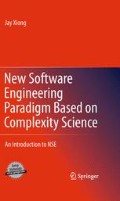Abstract
This chapter describes a prediction – a new round of industrial revolution driven by Complexity Science, and a paradigm-shift framework, the Five-Dimensional Structure Synthesis method (FDS). Many businesses fail because of an attempt to solve nonlinear problems with linear processes. With FDS, the paradigm shift for an industry can be performed efficiently – from the old-established paradigm based on linear thinking, reductionism, and superposition principle to a new paradigm based on nonlinear thinking and complexity science in compliance with the common principles of complexity science. FDS has been successfully used in the paradigm shift of the software industry and could be successfully used for other industries too.
Access this chapter
Tax calculation will be finalised at checkout
Purchases are for personal use only
References
Brooks FP Jr (1995) The mythical man-month. Addison-Wesley, Reading
Cockburn AAR (1999) Characterizing people as non-linear, first-order components in software development. HaT Technical Report 1999.03, Oct 21
Franklin B (1736) An ounce of prevention is worth a pound of cure. Philadelphia’s 1706–1790
Gharajedaghi J (2004) Systems methodology: a holistic language of interaction and design seeing through chaos and understanding complexities, http://www.acasa.upenn.edu/JGsystems.pdf
Hall AD (1962) A methodology for systems engineering. Van Nostrand, Princeton
Hall AD (1969) Three-dimensional morphology of systems engineering. IEEE Trans Syst Sci Cybern SSC-5(2):156–160
Jones C (2006) Social and technical reasons for software project failures. CrossTalk, June Issue
Kuhn T (1962) The structure of scientific revolutions. University of Chicago press, Chicago
Lindberg C (2005) Complexity, the science of relationships. Nursing, the profession of relationships. Plexus Institute, Allentown
McKelvey B (1999) Complexity theory in organization science: seizing the promise or becoming a fad? Emergence 1(1):5–32
Warfield JN (1996) Five schools of thought about complexity. In: Proceedings of the Society for Design and Process Science: integrated design and process technology, vol 2. SDPS, Austin
Zambonelli F, Van Dyke Parunak H (2003) Signs of a revolution in computer science and software engineering. Springer, Berlin, http://www.newvectors.net/staff/parunakv/ZambonelliParunakAOSE02.pdf
Author information
Authors and Affiliations
Corresponding author
Further Reading and Information Source
Further Reading and Information Source
-
(a)
Abran A, Moore JW, Bourque P, Dupuis R (eds) (2004) Guide to the software engineering body of knowledge – 2004 Version. IEEE Computer Society. p. 1–1. ISBN 0-7695-2330-7.
-
(b)
Bolton D. About.com Guide, Definition of Framework. http://cplus.about.com/od/glossar1/g/frameworkdefn.htm
Rights and permissions
Copyright information
© 2011 Springer Science+Business Media, LLC
About this chapter
Cite this chapter
Xiong, J. (2011). Prediction and Practices: A New Round of Industrial Revolution Driven by Complexity Science and a General Paradigm-Shift Framework. In: New Software Engineering Paradigm Based on Complexity Science. Springer, New York, NY. https://doi.org/10.1007/978-1-4419-7326-9_4
Download citation
DOI: https://doi.org/10.1007/978-1-4419-7326-9_4
Published:
Publisher Name: Springer, New York, NY
Print ISBN: 978-1-4419-7325-2
Online ISBN: 978-1-4419-7326-9
eBook Packages: EngineeringEngineering (R0)

